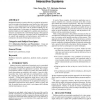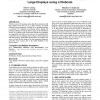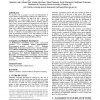145
Voted
EICS
2009
ACM
14 years 10 months ago
2009
ACM
Modularization is almost the only feasible way of implementing large-scale applications. For user interfaces, interactions involving more than one module generate dependencies bet...
101
Voted
EICS
2009
ACM
15 years 3 months ago
2009
ACM
Due to the large amount of mobile devices that continue to appear on the consumer market, mobile user interface design becomes increasingly important. The major issue with many ex...
95
Voted
EICS
2009
ACM
15 years 4 months ago
2009
ACM
This paper presents an approach for investigating in a predictive way potential disruptive effects of interruptions on task performance in a multitasking environment. The approach...
85
Voted
EICS
2009
ACM
15 years 4 months ago
2009
ACM
Distributed interactive systems often rely on platform information, used for example when migrating a user interface to a small-screen device, or when opportunistically recruiting...
105
Voted
EICS
2009
ACM
15 years 4 months ago
2009
ACM
Ubiquitous computing poses new usability challenges that cut across design and development. We are particularly interested in "spaces" enhanced with sensors, public disp...
101
Voted
EICS
2009
ACM
15 years 5 months ago
2009
ACM
MoLIC, a modeling language for designing interaction as a metaphor of conversation, was proposed to allow designers to build a blueprint of all interaction that may take place whe...
112
Voted
EICS
2009
ACM
15 years 5 months ago
2009
ACM
dTouch is a novel 3D pointing system that allows interaction with large displays from the use of a single webcam. An initial evaluation demonstrating the feasibility of our pointi...
82
Voted
EICS
2009
ACM
15 years 5 months ago
2009
ACM
As user interfaces become more and more complex and feature laden, usability tends to decrease. One possibility to counter this effect are intelligent support mechanisms. In this ...
109
Voted
EICS
2009
ACM
15 years 5 months ago
2009
ACM
Complex and dynamic interaction behaviors in applications such as Virtual Reality (VR) systems are difficult to design and develop. Reasons for this include the complexity and lim...
97
Voted
EICS
2009
ACM
15 years 5 months ago
2009
ACM
We describe work in progress on tools and infrastructure to support adaptive component-based software for mobile devices— in our case, Apple iPhones. Our high level aim is ‘de...



